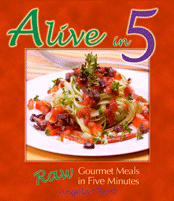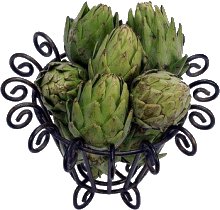Artichokes: The Phytochemical-Rich Thistle
Vegetable with an Interesting History
by www.SixWise.com
Artichokes are one of the oldest foods known to humans, yet
many Americans are wary of this prickly vegetable with the
tough exterior. However, if you've never tried an artichoke,
there is great reason to do so. Aside from being very tasty,
they're excellent for your health.
|

Artichokes were the fourth highest antioxidant food
according to a survey of more than 100 foods.
|
Artichokes have been grown since ancient times, with the
Greek philosopher Theophrastus even writing about them being
grown in Italy
and Sicily as far back as 371-287 B.C.
Interestingly, much later during the 16th century, only men
were allowed to eat artichokes, as they were considered an
aphrodisiac that would enhance sexual power.
In Ancient Greece, meanwhile, artichokes were thought to
be an effective food if you wanted to give birth to a boy.
And in the 1576 "Book of Nature," Dr. Bartolomeo
Boldo said of artichokes, "It has the virtue of ... provoking
Venus for both men and women; for women making them more desirable,
and helping the men who are in these matters rather tardy."
There are more than 140 known artichoke varieties, though
fewer than 40 are grown commercially. Although artichokes
are grown in France, Italy and Spain, the United States gets
their entire artichoke supply from California.
Artichokes: Antioxidant Powerhouses
Artichokes are an excellent source of fiber, vitamin C, magnesium
and potassium, but it is their phytonutrient content that
really makes them shine.
In fact, a study published in the July 2006 issue of the
American Journal of Clinical Nutrition found that artichokes
ranked fourth in antioxidant content out of over 100 tested
foods.
Artichokes were found to contain more antioxidants per serving
than blueberries, raspberries, spinach, broccoli, sweet potatoes
and a host of other fruits and vegetables (only blackberries,
walnuts and strawberries had more).
The phytonutrients (compounds in plants that have antioxidant
properties) in artichokes are known to:
Specifically, according to artichoke grower Ocean Mist Farms,
artichokes contain:
-
Quercetin: A flavonoid may protect against cancer and
heart disease.
-
Rutin: A flavonoid that "promotes vascular health,
helps prevent cell proliferation associated with cancer,
and has anti-inflammatory and anti-allergenic properties."
-
Anthocyanins: Antioxidants that may lower the risk of
cancer and promote urinary tract health, memory function
and healthy aging.
-
Gallic Acid: An antioxidant that has been shown to inhibit
cell proliferation in prostate cancer cells.
|

Alive
in 5: Raw Gourmet Meals in Five Minutes is the perfect
cooking companion for anyone who wants to get more fresh,
healthy and great-tasting fruits and vegetables into
their diet -- but doesn't have a lot of time to do it.
|
-
Luteolin and Cynarin: Antioxidants that may lower cholesterol.
-
Caffeic Acid and Chlorogenic Acid: These contain anti-cancer,
antimicrobial and anti-viral properties, and they may
help lower bad (LDL) cholesterol.
-
Silymarin: An antioxidant that may help the liver in
regenerative tissue growth.
How to Eat an Artichoke
The obvious factor that keeps many people from enjoying artichokes
is their outward appearance. But though they may look complicated,
cooking and enjoying artichokes is actually quite simple.
Here's what to do:
-
Wash the artichoke using cold, running water.
-
Trim the stem so it's about an inch or two long (but
not too short, because the stem is edible).
-
Cut about an inch off the top of the artichoke (so the
top is flat, rather than pointed).
-
Using scissors, trim the pointed tip off of each petal
(this is optional).
|

Don't be intimidated by artichokes; they're simple
to prepare. Just cut off the top, trim the stem and
tips from the petals, steam until tender and enjoy with
a little melted butter and lemon juice for dipping.
|
Artichokes can then be steamed (for about 30-50 minutes,
or until tender), boiled, grilled (after being steamed first),
or roasted (steam them for 10 minutes less than usual first).
To eat an artichoke in the traditional manner (whole), here's
what you need to know:
-
Eat the petals one at a time, pulling the soft meat through
your teeth, then discarding the remaining, tougher leaf.
-
You can eat the petals plain or dip them into melted
butter, lemon juice, mayonnaise, balsamic vinegar or any
sauce of your choice.
-
When you've reached the artichoke heart, remove the fuzzy
pinchers with a spoon, and eat the entire "heart"
and stem (the artichoke heart is considered the best part
of the artichoke).
Artichokes are also great when cooked into recipes, such
as the two delicious dishes you can try out below.
Artichoke Pissaladiere
Ingredients:
- 3-4 jumbo artichokes, steamed
- boiling salted water
- 3 large red onions
- 1/4 cup sugar
- 1/2 cup dry red wine
- 1 (16 oz.) Italian bread shell or brown-and serve focaccia
- 2 Tablespoons olive oil
- Herbs de Provance
- kosher salt
- 1 cup shredded asiago cheese
- 1/2 cup chopped kalamata olives
Directions:
- Remove leaves and choke from the cooked artichokes. Cut
heart into thin slices.
- Place onions, sugar and wine in heavy skillet. Cook on
medium-low heat, stirring occasionally until the onions
are translucent and all liquid has evaporated; cool before
using.
- Brush bread shell with oil (or halve focaccia horizontally
and brush cut surfaces with oil); sprinkle with herbs and
kosher salt. Top with caramelized red onions, cheese, olives
and artichokes.
- Bake at 375°F 25-30 minutes or until center is lightly
toasted and edges are golden brown. Cool. Cut into 8 wedges
and serve at room temperature.
Healthy Artichoke Dip
Ingredients:
- 4 large artichokes, steamed (mash the hearts, bottoms
and stems of the steamed artichoke for this recipe and save
the leaves for dipping)
- 1/2 cup non-fat or regular sour cream
- 1/2 cup green onions thinly sliced
- 1 teaspoon of garlic salt
- The juice from 1/2 a fresh lemon
- 2 teaspoons of grated Parmesan cheese
Directions:
- Preheat oven to 350 degrees.
- Combine mashed artichoke, sour cream, green onions, lemon
juice and garlic salt in a medium mixing bowl , making sure
that artichoke hearts, bottoms and stems are well mashed.
- Place artichoke mixture in a small oven-proof casserole
dish and sprinkle Parmesan cheese on top of dip.
- Bake in oven for 25 minutes and serve warm or cold with
fresh veggies, artichoke leaves or a thinly sliced baguette
for dipping.
Recommended Reading
The
11 Healthiest Autumn Fruits and Vegetables
10
Top Foods to Help You Fight High Cholesterol
Sources
American
Journal of Clinical Nutrition, Vol. 84, No. 1, 95-135, July
2006
Ocean
Mist Farms
WhatsCookingAmerica.net